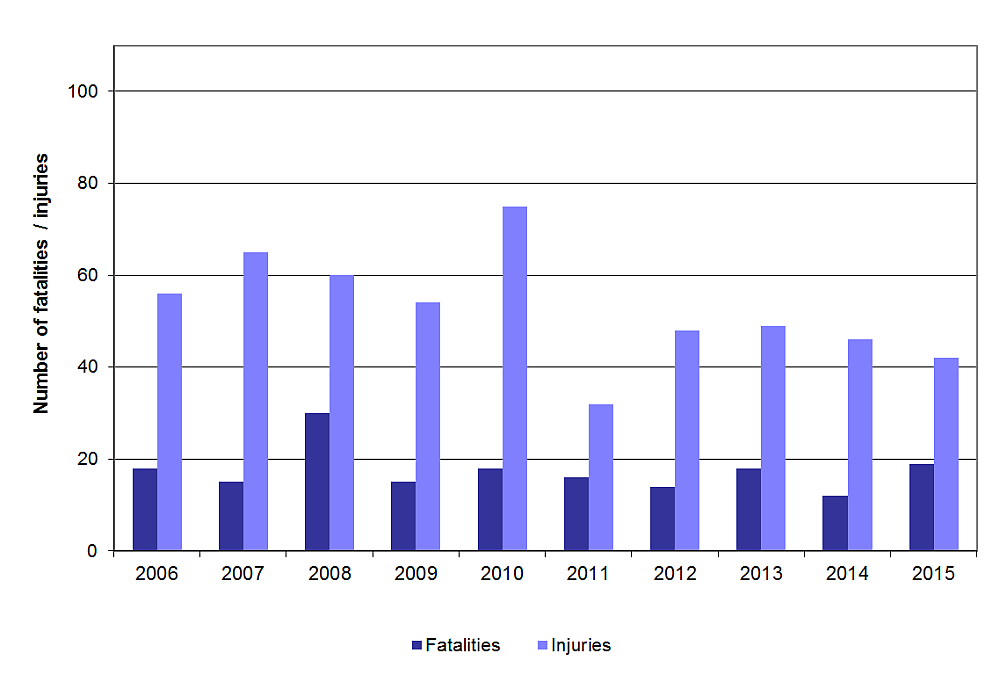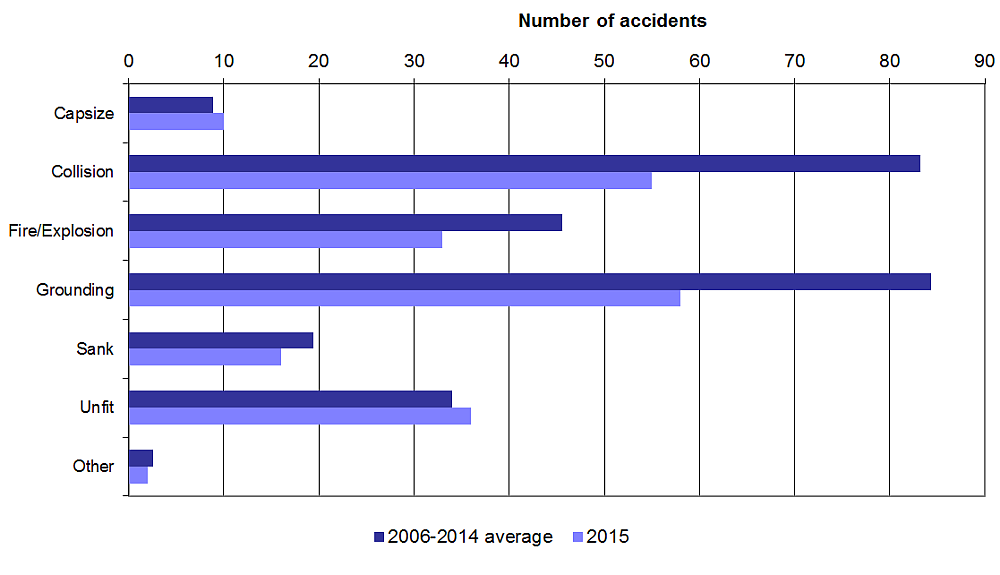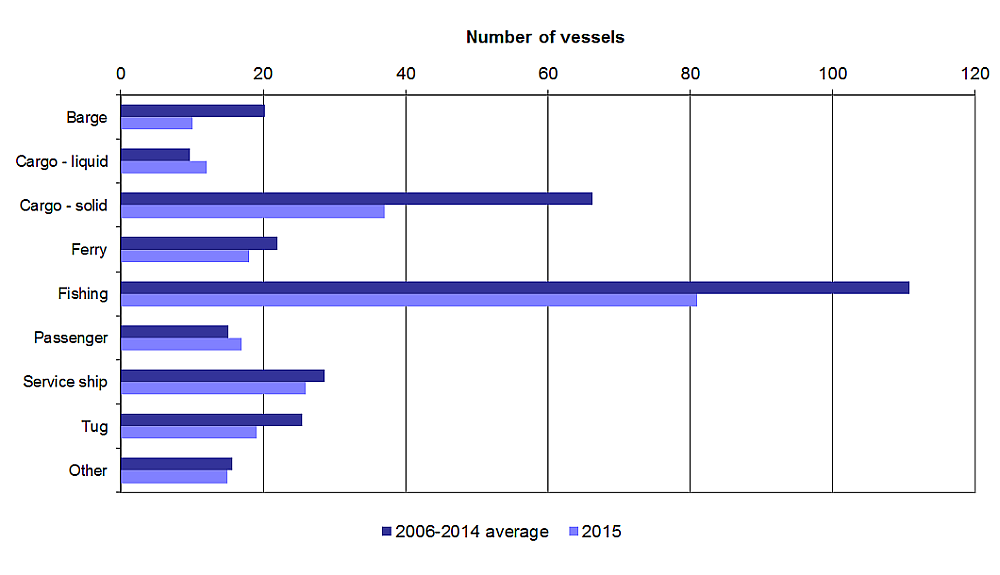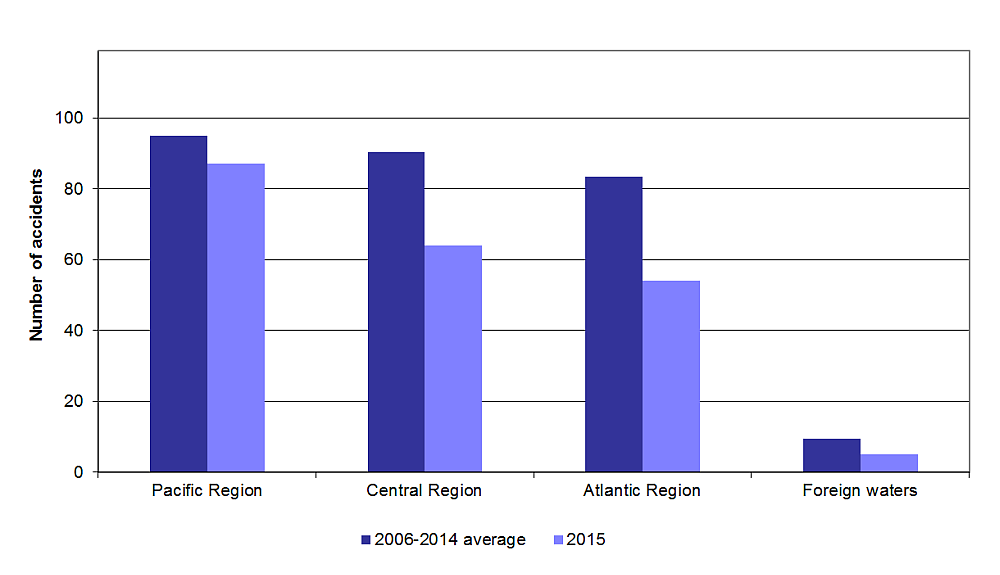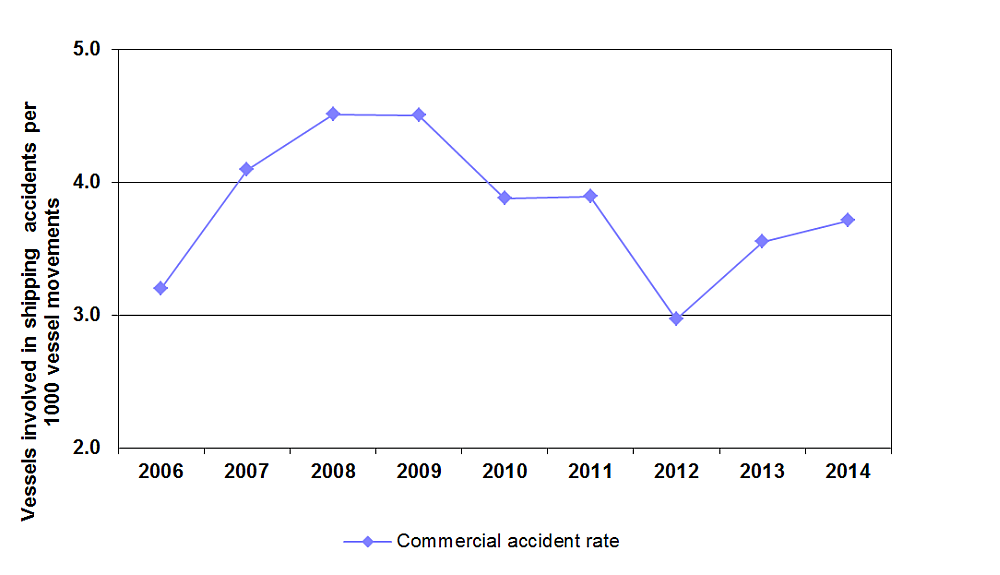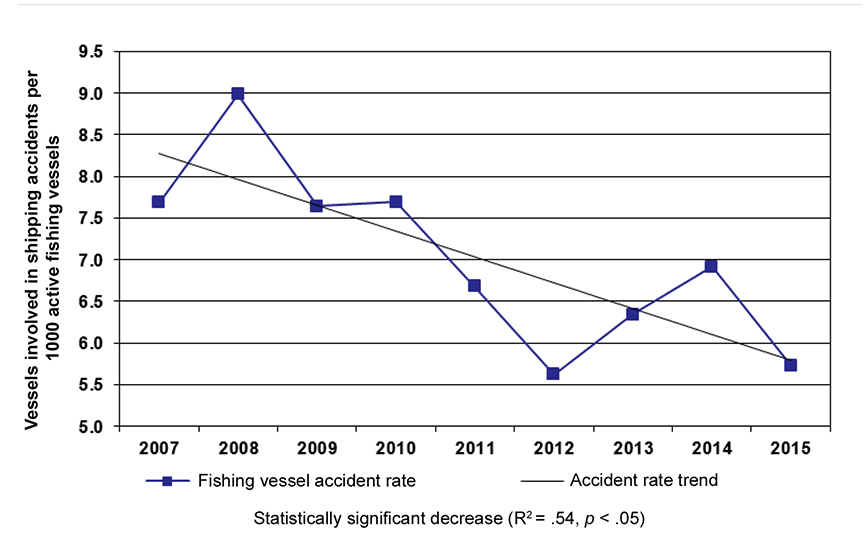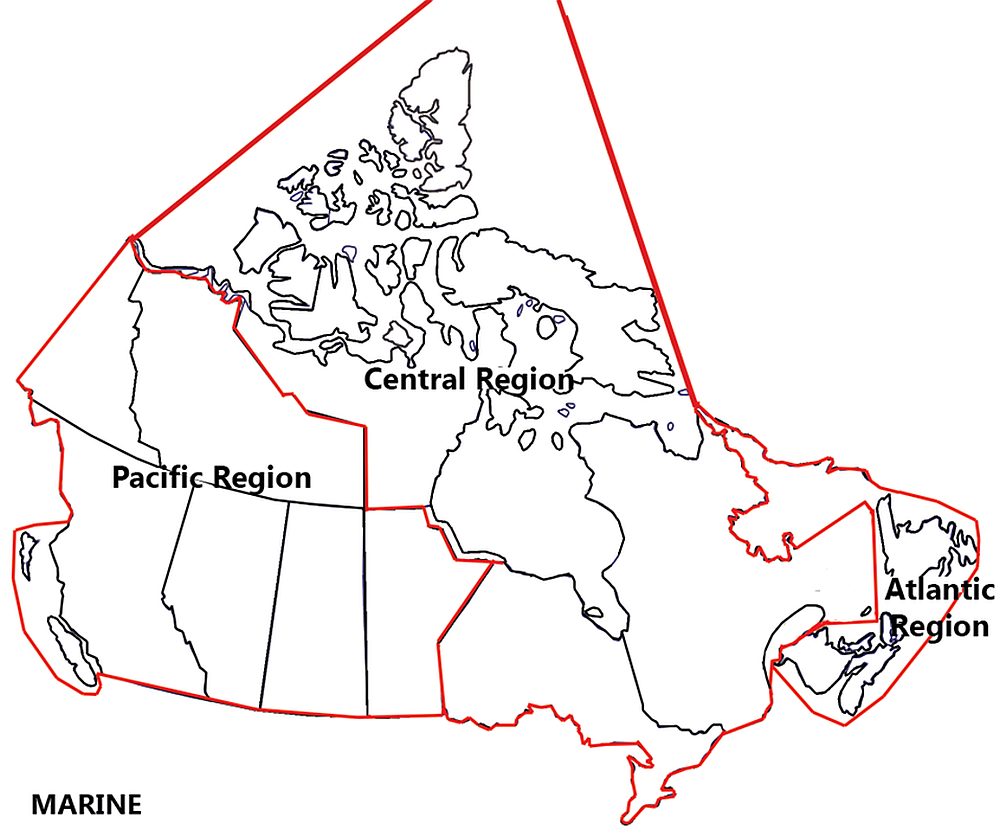Foreword
This document is a summary of selected 2015 marine safety data. It covers commercial vessels, which include all vessels registered or licensed to operate commercially. Pleasure craft occurrences are not normally included unless they also involve a commercial vessel.
The TSB gathers and uses this data during the course of its investigations to analyse safety deficiencies and identify risks in the Canadian transportation system.
The 2015 data were collected according to the reporting requirements described in the TSB Regulations in force during that calendar year.
The statistics presented here reflect the TSB database at 12 April 2016. Since the occurrence data are constantly being updated in the live database, the statistics may change slightly over time.
Because many occurrences are not formally investigated, information recorded on some occurrences may not have been verified. Consequently, be cautious in using these statistics.
The following series of data tables are also associated with this annual summary:
- Marine occurrences (types, vessels and losses involved) 2006-2015
- Details of occurrences, losses and vessels involved by region 2006-2015
- Canadian-flag vessels involved in shipping accidents by vessel category and type of accident 2006-2015
- Foreign-flag vessels involved in shipping accidents by vessel category and type of accident 2006-2015
- Vessels lost by vessel category and age 2006-2015
- Accidents, fatalities and serious injuries by accidents type 2006-2015
- Vessels, fatalities and serious injuries by vessel type 2006-2015
Accidents
Overview of accidents and casualties
In 2015, 245 marine accidents (see Definitions below) were reported to the TSB, down from the 2014 total of 301, and down from the 2010–2014 average of 300. Over the past 10 years, 83% of marine accidents were shipping accidents, while the remainder were accidents aboard ship.
There were 210 shipping accidents in 2015, down 16% from the 2014 total of 249, and down 15% from the 2010–2014 average of 246 (Figure 1).
Figure 1 data
| Year | Shipping accidents | Accidents aboard ship |
|---|---|---|
| 2006 | 327 | 52 |
| 2007 | 331 | 76 |
| 2008 | 313 | 69 |
| 2009 | 301 | 57 |
| 2010 | 274 | 63 |
| 2011 | 254 | 41 |
| 2012 | 215 | 52 |
| 2013 | 238 | 61 |
| 2014 | 249 | 52 |
| 2015 | 210 | 35 |
In 2015, there were 35 accidents aboard ship, down from 52 in 2014 and down from the 2010–2014 average of 54. The majority of accidents aboard ship occurred on fishing vessels (60%) and ferry/passenger vessels (23%).
Marine fatalities totalled 19 in 2015 (Figure 2), up from a total of 12 in 2014 and up from the average of 16 in 2010–2014. A whale-watching vessel accident (Ferry/Passenger) accounted for 6 of the 13 shipping accident fatalities in 2015, and fishing vessel shipping accidents accounted for 6 of the 13 fatalities. In addition, accidents aboard fishing vessels led to 5 of the 6 accident aboard ship fatalities. In total, there were 11 fishing vessel fatalities in 2015, unchanged from the annual average of 11 in 2010-2014.
Serious injuries in 2015 totalled 42, down from 46 in 2014 and down from the annual average of 50 in 2010–2014. Thirty of the 42 serious injuries resulted from accidents aboard ship.
Figure 2 data
| Year | Fatalities | Injuries |
|---|---|---|
| 2006 | 18 | 56 |
| 2007 | 15 | 65 |
| 2008 | 30 | 60 |
| 2009 | 15 | 54 |
| 2010 | 18 | 75 |
| 2011 | 16 | 32 |
| 2012 | 14 | 48 |
| 2013 | 18 | 49 |
| 2014 | 12 | 46 |
| 2015 | 19 | 42 |
Shipping accidents
Type of accident
As illustrated in Figure 3, the most frequent types of shipping accidents in 2015 were groundings (28%), collisions (26%), sustains damage rendering unseaworthy/unfit for purpose accidents (17%), and fire/explosion accidents (16%). The total number of collisions decreased by 31% (from 79 to 55) and the number of groundings decreased by 21% from the five-year average (from 73 to 58). Sustains damage rendering unseaworthy/unfit for purpose accidents increased by 18% (from 30 to 36). This increase may be attributable to some shorter ice seasons within the previous five-year period. Fire/explosion accidents decreased by 16% compared to the five year average (from 39 to 33).
Figure 3 data
| Accident type | 2006-2014 average | 2015 |
|---|---|---|
| Capsize | 9 | 10 |
| Collision | 83 | 55 |
| Fire/Explosion | 46 | 33 |
| Grounding | 84 | 58 |
| Sank | 19 | 16 |
| Unfit | 34 | 36 |
| Other | 3 | 2 |
Type of vessel
Eighty one fishing vessels (34% of the total) were involved in shipping accidents (Figure 4), down from the 92 (33%) in 2014 and down from the 2010–2014 average of 94 (34%). After fishing vessels, 37 cargo-solid vessels (16%) and 26 service ships (11%) were involved most often in shipping accidents in 2015.
Figure 4 data
| Type of vessel | 2006-2014 average | 2015 |
|---|---|---|
| Barge | 20 | 10 |
| Cargo - liquid | 10 | 12 |
| Cargo - solid | 66 | 37 |
| Ferry | 22 | 18 |
| Fishing | 111 | 81 |
| Passenger | 15 | 17 |
| Service ship | 29 | 26 |
| Tug | 25 | 19 |
| Other | 16 | 15 |
Geographical region
In 2015, 41% of shipping accidents occurred in the Pacific region, 30% in the Central region, 26% in the Atlantic region, and the remaining 2% of shipping accidents took place in foreign waters (Figure 5). In the Pacific region shipping accidents were unchanged from the 2010–2014 average of 87, in the Central region shipping accidents decreased by 20% (from 80 to 64), and in the Atlantic region shipping accidents decreased by 22% (from 70 to 54).
Fishing vessels accounted for 74% of all vessels involved in shipping accidents in the Atlantic region, down 17% from the 2010-2014 average (from 51 to 42); and 33% in the Pacific region, down 6% from the 2010-2014 average (from 35 to 33).
Figure 5 data
| Region | 2006-2014 average | 2015 |
|---|---|---|
| Pacific Region | 95 | 87 |
| Central Region | 90 | 64 |
| Atlantic Region | 83 | 54 |
| Foreign waters | 9 | 5 |
Vessel flag
In 2015, 86% of the 235 vessels involved in shipping accidents reported to the TSB were Canadian-flag vessels. In all, 41% of the Canadian-flag vessels were commercial non-fishing vessels, 39% were fishing vessels and the remaining 20% were non commercial vessels, pleasure craft or service vessels.
According to information provided by Transport Canada, marine activity for Canadian commercial non-fishing vessels over 15 gross tons (grt) (excluding passenger vessels and cruise ships) was estimated to be 28,550 commercial movements in 2015, which is a 2% increase from the 2010–2014 average of 28,122 commercial movements. This yields a rate of 2.9 accident-involved commercial vessels per 1,000 commercial movements, down from the five-year average of 3.6 (Figure 6).
Figure 6 data
| Year | Commercial accident rate |
|---|---|
| 2006 | 3.2 |
| 2007 | 4.1 |
| 2008 | 4.5 |
| 2009 | 4.5 |
| 2010 | 3.9 |
| 2011 | 3.9 |
| 2012 | 3.0 |
| 2013 | 3.6 |
| 2014 | 3.7 |
| 2015 | 2.9 |
In 2015, there were an estimated 13,953 active fishing vessels in CanadaFootnote 1. The shipping accident rate for Canadian fishing vessels decreased from 6.9 fishing vessels involved in shipping accidents per 1000 active fishing vessels in 2014 to 5.7 in 2015 and decreased from the five-year average of 6.7. There has been a statistically significant downward trend in the Canadian fishing vessel shipping accident rate over the last 10 years (p<.05) (Figure 7).
Figure 7 data
| Year | Fishing vessel accident rate |
|---|---|
| 2006 | 7.5 |
| 2007 | 7.7 |
| 2008 | 9.0 |
| 2009 | 7.6 |
| 2010 | 7.7 |
| 2011 | 6.7 |
| 2012 | 5.6 |
| 2013 | 6.3 |
| 2014 | 6.9 |
| 2015 | 5.7 |
For Canadian-flag fishing vessels in 2015, groundings (41%) and fire/explosion accidents (18%) were the most frequent shipping accident types. Canadian-flag commercial non-fishing vessels were mostly involved in collisions (41%) or groundings (17%).
In 2015, 32 foreign-flag vessels were involved in shipping accidents in Canadian waters, 30 of which were commercial non-fishing vessels. According to information provided by Transport Canada, marine activity for foreign commercial non-fishing vessels was 26,300 commercial movements in 2015, comparable to the 2010-2014 average of 26,220 commercial movements. This yields an accident rate of 1.1 commercial vessels involved in shipping accidents per 1000 commercial movements, down from the five-year average of 1.6.
Vessels lost
In 2015, 23 vessels were reported lost, up from 20 in 2014, and up from the 2010–2014 average of 22. Fifteen of the 23 vessels lost in 2015 were fishing vessels. Eight of the 23 vessels lost were less than 15 grt, and 70% were at least 20 years old. During the past 10 years, fishing vessels under 60 grtFootnote 2 have accounted for more than 60% of the vessels lost in Canada.
Incidents
Overview of incidents
In 2015, 707 marine incidents (see Definitions below) were reported to the TSB, down from a total of 747 in 2014, but up from the annual average of 438 in 2010–2014. On March 12, 2014, the TSB issued new regulations that changed the reporting requirements effective July 1, 2014. The new regulations clarify the reporting requirements for a total failure of any machinery or technical system, leading to an increase in this category since 2014. The 2013 increase was related to the clarification of the threshold used to classify the engine / rudder/propeller incident category, which is now included in the total failure of any machinery or technical system incident category.
In 2015, incidents in the Atlantic region represented 45% of all marine incidents followed by 37% in the Pacific region, and 16% in the Central region. The remaining 2% of reported incidents took place in foreign waters.
The majority of reportable incidents consisted of total failure of any machinery or technical systems (83%%) (Figure 8). The Atlantic region had the majority of total failure of any machinery or technical systems incidents (50%) and the Pacific region had the majority of bottom contact incidents (53%).
In 2014, vessels most often involved in total failure of any machinery or technical systems incidents were fishing vessels (65%) and cargo-solid vessels (14%).
Figure 8 data
| Marine Incidents by Type | Number | Percentage |
|---|---|---|
| Bottom contact | 36 | 5% |
| Cargo shift/Cargo loss | 4 | 1% |
| Person overboard | 13 | 2% |
| Risk of collision (near collision) | 30 | 4% |
| Risk of sinking | 10 | 1% |
| Total failure of any machinery or technical system | 589 | 83% |
| Other incident types | 25 | 4% |
Definitions
The following definitions apply to marine occurrences that are required to be reported pursuant to the Canadian Transportation Accident Investigation and Safety Board Act and the TSB regulations.
Marine occurrence
- any accident or incident associated with the operation of a ship and
- any situation or condition that the Board has reasonable grounds to believe could, if left unattended, induce an accident or incident described above.
Marine accident
An accident resulting directly from the operation of a ship other than a pleasure craft, where
Accident aboard ship
- a person is killed or sustains a serious injury as a result of
- boarding, being on board or falling overboard from the ship, or
- coming into direct contact with any part of the ship or its contents;
Shipping accident
- the ship
- sinks, founders or capsizes,
- is involved in a collision [includes strikings and contacts],
- sustains a fire or an explosion,
- goes aground,
- sustains damage that affects its seaworthiness or renders it unfit for its purpose, or
- is missing or abandoned
Marine incident
- A person falls overboard from the ship;
- The ship
- makes unforeseen contact with the bottom without going aground;
- fouls a utility cable or pipe, or an underwater pipeline;
- is involved in a risk of a collision;
- sustains a total failure of
- the navigation equipment if the failure poses a threat to the safety of any person, property or the environment,
- the main or auxiliary machinery, or
- the propulsion, steering, or deck machinery if the failure poses a threat to the safety of any person, property or the environment.
- all or part of the ship’s cargo shifts or falls overboard; or
- is anchored, grounded or beached to avoid an occurrence,
- a crew member whose duties are directly related to the safe operation of the ship is unable to perform their duties as a result of a physical incapacitation which poses a threat to the safety of persons, property or the environment;
- there is an accidental release on board or from the ship consisting of a quantity of dangerous goods or an emission of radiation that is greater than the quantity or emission levels specified in Part 8 of the Transportation of Dangerous Goods Regulations.
Serious injury
- A fracture of any bone, except simple fractures of fingers, toes or the nose;
- Lacerations that cause severe hemorrhage or nerve, muscle or tendon damage;
- An injury to an internal organ;
- Second or third degree burns, or any burns affecting more than 5% of the body surface;
- A verified exposure to infectious substances or injurious radiation; or
- An injury that is likely to require hospitalization.
Vessels covered
This report covers commercial vessels that include all vessels either registered or licensed to operate commercially. Pleasure craft occurrences are not normally included unless they also involved a commercial vessel.
Vessel categories
Commercial Vessels: include cargo vessels, ferries, passenger vessels, tugs and barges.
Fishing Vessels: include vessels involved in commercial fishing.
Other Vessels: include research vessels, oil exploration, exploitation and support vessels, government vessels and pleasure craft.
Miscellaneous
Gross tons (grt): A measure of vessel capacity in cubic feet of the spaces within the hull, and of enclosed spaces above deck available for cargo, stores, fuel, passengers and crew, with certain exclusions. One hundred cubic feet is equivalent to one gross ton.
Movement: A vessel’s travel segment between ports with at least one port being a domestic port.
Regional limits
Pacific Region’s area of responsibility consists of the provinces of British Columbia, Alberta, Saskatchewan, and Manitoba, the Yukon and the Northwest Territories south of the 70th parallel, as well as the waters adjacent to these provinces and territories.
Central Region’s area of responsibility consists of the provinces of Ontario and Quebec (including the Magdalen Islands), the territory of Nunavut, and the Northwest Territories north of the 70th parallel, as well as James Bay, Hudson Bay, the St. Lawrence Seaway, and the Great Lakes waterways up to the Canada-US border.
Atlantic Region’s area of responsibility consists of the provinces of New Brunswick, Nova Scotia, Prince Edward Island, and Newfoundland and Labrador, as well as the waters adjacent to these provinces.

